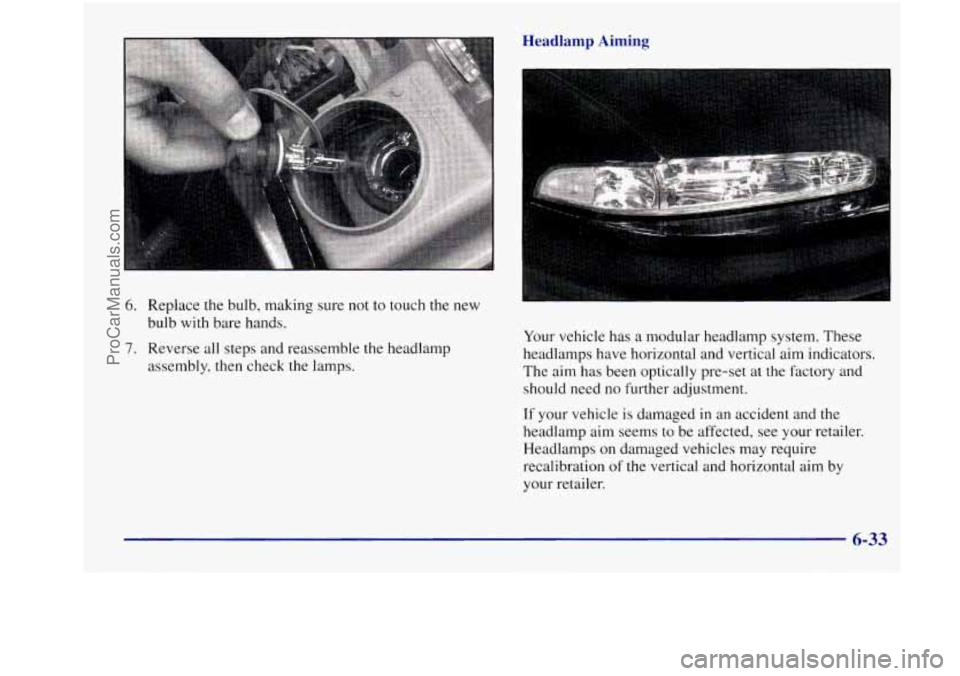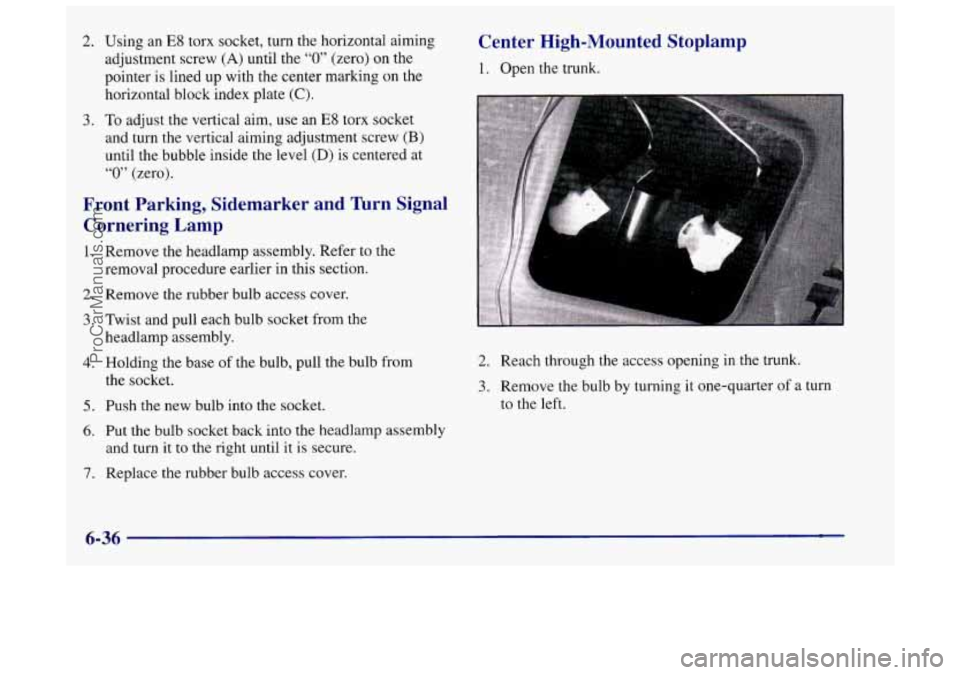OLDSMOBILE INTRIGUE 1998 Owners Manual
Manufacturer: OLDSMOBILE, Model Year: 1998, Model line: INTRIGUE, Model: OLDSMOBILE INTRIGUE 1998Pages: 340, PDF Size: 17.93 MB
Page 261 of 340

6. Replace the bulb, making sure not to touch the new
bulb with bare hands.
7. Reverse all steps and reassemble the headlamp
assembly, then check the lamps.
Headlamp Aiming
Your vehicle has a modular headlamp system. These
headlamps have horizontal and vertical aim indicators.
The aim has been optically preset at the factory and
should need no further adjustment.
If your vehicle is damaged in an accident and the
headlamp aim seems to be affected, see your retailer.
Headlamps on damaged vehicles may require
recalibration of the vertical and horizontal aim by
your retailer.
6-33
ProCarManuals.com
Page 262 of 340

To check the aim, the vehicle should be properly
prepared as follows: For the vertical adjustment, state inspection stations
will generdy dhw areading of plus 0.76 degrees or
minus 0.76 degrees from the center of the bubble. 0
0 Place the vehicle on a level pad or surface.
The vehicle should not have any snow, ice or mu(
attached to it.
0
0
0
0
0
1
The vehicle should be fully assembled and all other
work stopped while headlamp aiming is being done.
There should not be any cargo or loading of the
vehicle, except it should have a
full tank of gas and
one person
or 160 lbs. (75 kg) on the driver's seat.
Close
all doors.
Tires should be properly inflated.
Rock the vehicle to stabilize the suspension.
NOTICE:
To make sure your headlamps are aimed
properly, read all the instructions before
beginning. Failure to follow these instructions could cause damage to headlamp parts.
Dl .2" .4"
It is recommended that the
upper limit not exceed
plus
0.4 degrees from the
center of the bubble.
Other drivers may flash
their high beams at you
if
your adjustment is much
above plus
0.4 degrees.
6-34
ProCarManuals.com
Page 263 of 340

If you find that the headlamp aiming needs adjustment,
follow these steps:
A. Horizontal aim adjustment screw
B. Vertical aim adjustment screw
1. Start by opening the hood and locating the vertical
and horizontal aim indicators. The aiming screw for
the horizontal aim indicator is on the outboard side
of the headlamp cover
(A) and the aiming screw for
the vertical aim indicator
is on the inboard side (B).
NOTICE:
Horizontal aim of the headlamp must be done
first. Adjusting vertical aim first will result in
incorrect headlamp aim.
B. Vertical aim adjustment screw
C. Horizontal block index plate
D. Vertical aiming level
6-35
ProCarManuals.com
Page 264 of 340

2. Using an E8 torx socket, turn the horizontal aiming
adjustment screw
(A) until the “0” (zero) on the
pointer
is lined up with the center marking on the
3.
1.
-
horizontal block index plate (C).
To adjust the vertical aim, use an E8 torx socket
and turn the vertical aiming adjustment screw
(B)
until the bubble inside the level (D) is centered at
“0” (zero).
Front Parking, Sidemarker and Turn Signal
Cornering Lamp
Remove the headlamp assembly. Refer to the
removal procedure earlier in this section.
2.
3.
4.
5.
6.
Remove the rubber bulb access cover.
Twist and pull each bulb socket from the
headlamp assembly.
Holding the base
of the bulb, pull the bulb from
the socket.
Push the new bulb into the socket.
Put the bulb socket back into the headlamp assembly
and
turn it to the right until it is secure.
Redace the rubber bulb access cover.
I
Center High-Mounted Stoplamp
1. Open the trunk.
Lr
2. Reach through the access opening in the trunk.
3. Remove the bulb by turning it one-quarter of a turn
to the left.
6-36
ProCarManuals.com
Page 265 of 340

4. Place the new bulb into the socket.
5. Turn the bulb one-quarter of a turn to the right
to replace.
6. Close the trunk.
TaiVStopDbrn Signal lamp
A A
B
1. Remove the plastic wing nuts (A). (Pliers may be
required to remove the wing nuts.)
6-37
ProCarManuals.com
Page 266 of 340

2.
3.
4.
5.
6.
7.
8.
9.
Pull the taillamp housing away from the body ol:
the vehicle (B).
Squeeze the tab on the bulb socket and turn the
socket right to left.
Pull out the bulb socket.
Pull the bulb out
of the socket. (There are four
bulbs
on each taillamp.)
Push in
a new bulb.
Replace the bulb socket into the housing and turn to
the right.
Replace the taillamp housing to the body
of
the vehicle.
Install the wing nuts.
Windshield Wiper Blade Replacement
1. Pull the windshield wiper arm away from
the windshield.
IO. Tighten the plastic nuts.
2. While holding the wiper arm away from the glass,
push the release clip from under the blade
connecting point and
pull the blade assembly down
toward the glass to remove
it from the wiper arm.
3. Push the new wiper blade securely on the wiper arm
until you hear the release “clip” into place.
For wiper blade replacement length and type, also see
“Capacities and Specifications”
in the Index.
6-38
ProCarManuals.com
Page 267 of 340

Tires CAUTION: (Continued)
Your new vehicle comes with high-quality tires made by
a leading tire manufacturer.
If you ever have questions
about your tire warranty and where to obtain service, see
your Oldsmobile Warranty booklet
for details.
Poorly maintained and improperly used tires
are dangerous.
Overloading your tires can cause
overheating as a result of too much friction.
You could have an air-out and a serious
accident. See “Loading Your Vehicle” in
the Index.
CAUTION: (Continued)
0
0
0
Underinflated tires pose the same danger as
overloaded tires. The resulting accident
could cause serious injury. Check all tires
frequently
to maintain the recommended
pressure. Tire pressure should
be checked
when your tires are cold.
Overinflated tires are more likely to be
cut, punctured or broken by a sudden
impact
-- such as when you hit a pothole.
Keep tires at the recommended pressure.
Worn, old tires can cause accidents.
If your
tread is badly worn, or if your tires have
been damaged, replace them.
6-39
ProCarManuals.com
Page 268 of 340

Inflation -- Tire Pressure
The Tire-Loading Information label, which is located
inside the trunk lid, shows the correct inflation pressures
for your tires when they’re cold. “Cold” means your
vehicle has been sitting for at least three hours or driven
no more than 1 mile (1.6 km).
NOTICE:
Don’t let anyone tell you that underinflation or
overinflation is all right. It’s not. If your tires
don’t have enough air (underinflation), you can
get the following:
Too much flexing
0 Too much heat
Tire overloading
0 Bad wear
Bad handling
0 Bad fuel economy.
NOTICE: (Continued) NOTICE: (Continued)
If your tires have too much air (overinflation),
you can get the following:
Unusual wear
Bad handling
Rough ride
Needless damage from road hazards.
When to Check
Check your tires once a month
or more.
Don’t forget your compact spare tire.
It should be at
60 psi (420 Pa).
How to Check
Use a good quality pocket-type gage to check tire
pressure.
You can’t tell if your tires are properly inflated
simply by looking at them. Radial tires may look
properly inflated even when they’re underinflated.
Be sure to put the valve caps back on
the valve stems.
They help prevent leaks by keeping
out dirt and moisture.
6-40
ProCarManuals.com
Page 269 of 340

Tire Inspection and Rotation
Tires should be rotated every 6,000 to 8,000 miles
(10 000 to 13 000 km). Any time you notice unusual
wear, rotate
your tires as soon as possible and check
wheel alignment.
Also check for damaged tires or wheels.
See “When It’s Time for New Tires” and “Wheel
Replacement” later
in this section for more information.
The purpose of regular rotation is to achieve more
uniform wear for all tires on the vehicle. The first
rotation is the most important. See “Scheduled
Maintenance Services” in the Index for scheduled
rotation intervals.
I
Don’t include the compact spare tire in your tire rotation.
After the tires have been rotated, adjust the front and rear
inflation pressures as shown on the Tire-Loading Information label. Make certain that
all wheel nuts are
properly tightened. See “Wheel Nut Torque” in the Index.
A CAUTION:
Rust or dirt on a wheel, or on the parts to which
it is fastened, can make wheel nuts become loose
after a time. The wheel could come off and cause
an accident. When you change
a wheel, remove
any rust or dirt from places where the wheel
attaches to the vehicle. In an emergency, you can
use a cloth or a paper towel to do this; but be
sure to use a scraper or wire brush later,
if you
need to, to get all the rust or dirt
off. (See
“Changing a Flat Tire” in the Index.)
When rotating your tires, always use the correct rotation
pattern shown here.
6-41
ProCarManuals.com
Page 270 of 340

When It’s Time for New Tires
One way to tell when it’s
time for new tires is to
check the treadwear indicators, which will
appear when your tires have
only
1/16 inch (1.6 mm) or
less of tread remaining.
You need a new tire if any of the following statements
are true:
You can see the indicators at three or more places
You can see cord or fabric showing through the
The tread or sidewall is cracked, cut or snagged deep
enough to show cord or fabric.
The tire has a bump, bulge or split.
The tire has a puncture, cut or other damage that
around
the tire.
tire’s rubber.
can’t be repaired well because of the size or location
of the damage.
Buying New Tires
To find out what kind and size of tires you need, look at
the Tire-Loading Information label.
The tires installed on your vehicle when it was new had
a Tire Performance Criteria Specification (TPC Spec)
number on each tire’s sidewall. When you get new tires,
get ones with that same TPC Spec number. That way
your vehicle will continue to have tires that are designed
to give proper endurance, handling, speed rating,
traction, ride and other things during normal service on
your vehicle. If your tires have an all-season tread
design, the TPC number will be followed by an
“MS”
(for mud and snow).
If you ever replace your tires with those not having a
TPC Spec number, make sure they are the same size,
load range, speed rating and construction type (bias,
bias-belted or radial) as your original tires.
6-42
ProCarManuals.com